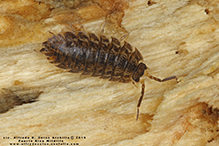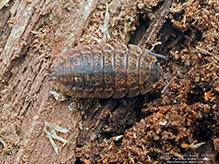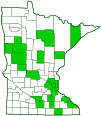Rathke’s woodlouse
(Trachelipus rathkii)
Conservation • Description • Habitat • Biology • Distribution • Taxonomy
|
|
||||||||||||||
Description |
Rathke’s woodlouse is an exotic isopod. It is native to central Europe and was introduced into North America. It now occurs from Newfoundland south to Tennessee and west to South Dakota. It is not uncommon in Minnesota. It is found in places with at least some dampness, including on rotting logs; under logs, stones, and boards; and in woodsheds and greenhouses. It is mostly a scavenger, eating plant and animal organic matter, but sometimes also feeds on living plants. Adults are 3⁄16″ to 7⁄16″ (5 to 10.5 mm) in length, a little more than two times longer than wide. The body is oval in outline. It is compressed along its upper and lower sides (dorsoventrally flattened). It is dark brown with wavy pale lines, giving it a mottled look. There is a blackish longitudinal stripe down the middle and a row of pale spots on each side near the lateral margin. The head is about twice as wide as long. It has three lobes in front; a broadly rounded lobe in the center, and a longer, narrower, rounded lobe on each side. There are two small compound eyes, one on each side of the head, and no simple eyes. There are two pairs of antennae. The first pair are small and have just two segments. The second pair has five segments and a whip-like tip (flagellum) with two segments. The fourth antennal segment is twice as long as the third, and the fifth is one-and-a-half times as long as the fourth. The segments of the flagellum are of equal length. The thorax has seven segments of slightly unequal length. There is a single leg-like appendage on each side of each segment. The upper exoskeletal plate (tergite) on each thoracic segment and the first five abdominal segments is curved outward at each lateral margin. The rear (posterior) angle on each side is produced rearward. On the first thoracic tergite, the front (anterior) angle on each side is also produced forward. The abdomen six segments, all of which are distinct. The lateral portions of the first two abdominal tergites are concealed beneath the seventh thoracic tergite. The third, fourth, and fifth tergites have the rear corners of the lateral margins produced, continuing the oval outline of the body. The last segment, the sixth, is called the telson. The telson is triangular. On each side of the telson there is an elongated appendage, called a uropod. The uropods project well beyond the end of the body. On the under (ventral) side of the abdomen there are 5 pairs of lungs appearing as white patches. |
Size |
Total length: 3⁄16″ to 7⁄16″ (5 to 10.5 mm) |
Similar Species |
Habitat |
On rotting logs; under logs, stones, and boards; and in woodsheds and greenhouses. |
Biology |
Season |
|
Behavior |
Unlike pill woodlice (Family Armadillidae), Rathke’s woodlouse cannot roll into a ball. |
Lifespan |
|
Life Cycle |
|
Food |
Plant and animal organic matter |
Distribution |
||
|
Sources |
|
| 9/26/2024 | ||
Occurrence |
||
Not uncommon in Minnesota |
||
Taxonomy |
|
Subphylum |
Crustacea (crustaceans) |
Superclass |
Multicrustacea (typical crustaceans) |
Class |
Malacostraca (malacostracans) |
Subclass |
Eumalacostraca (decapods, isopods, and allies) |
Superorder |
Peracarida (amphipods, isopods, and allies) |
Order |
Isopoda (Isopods) |
Suborder |
Oniscidea (woodlice, pillbugs, and rock slaters) |
Infraorder |
Holoverticata (woodlice and pillbugs) |
Zoosection |
Crinocheta |
Family |
Trachelipodidae |
Genus |
Trachelipus |
Subordinate Taxa |
|
|
|
Synonyms |
|
Porcellio (Euporcellio) affinis Porcellio confluens Porcellio ochraceus Porcellio parietinus Porcellio (Euporcellio) rathkei Porcellio (Euporcellio) rathkei var. rathkei Porcellio striatus Porcellio sylvestris Porcellio taeniatus Porcellio tetramoerus Porcellio trilineatus Porcellio trivittatus Porcellio varius Porcellio vittatus Trachelipus affinis Trachelipus waechtleri Tracheoniscus rathkei (misspelling) |
|
Common Names |
|
Rainbow Isopod Rathke’s woodlouse Rathkes woodlouse |
|
Glossary
Tergum; tergite
The upper (dorsal), hardened plate on a segment of the thorax or abdomen of an arthropod or myriapod. Plural: terga.
Uropod
On some crustaceans, a pair of appendages on the sixth and final abdominal segment. On lobsters and similar species, it forms part of the tail fan.
Visitor Photos |
||
Share your photo of this crustacean. |
||
This button not working for you? |
||
Alfredo Colon |
||
 |
 |
|
MinnesotaSeasons.com Photos |
||
|
||
|

Slideshows |
|

Visitor Videos |
||
Share your video of this crustacean. |
||
This button not working for you? |
||
|
Other Videos |
||
Trachelipus rathkii, Time Lapse |
About
Mar 24, 2020 I wanted to make a nice little video of my friends eating their dinner, so I started recording a time lapse and walked away. I came back in an hour or so to find that my phone had stopped recording long ago. Bummer. |

Created: 11/9/2020 Last Updated: © MinnesotaSeasons.com. All rights reserved. |



